At first glance, it looks much like any mid-20th century factory scene.
Women seated at tables, hard at work making clothes.
But it is their shell-shocked expressions that are the giveaway – signs that they are unwilling participants in one of the lesser-known horrors of the Second World War.
As a new exhibition highlights, it was amidst the death and disease of the Lodz Ghetto in occupied Poland that Jewish men, women and children were forced to make clothes and luxury goods for the Nazi regime and Third Reich civilians.
These luxury items included dresses, underwear, hats, footwear and ties made from materials taken from Jews murdered in the nearby Kulmhof am Nehr extermination camp just 30 miles away.
Other chilling photos show displays of children’s clothes and ladies dresses; a well-dressed man inspecting ties while standing next to a Jew with the Star of David pinned to his jacket; and a ‘look book’ for a man’s suit and a women’s jumper.
Yet others show Nazi uniforms and insignia and a pile of clothes from the extermination camp strewn across a street in the ghetto.
Taken for propaganda purposes by Walter Genewein, the Nazis’ chief accountant in the Lodz ghetto, the photos reveal a hideous exploitation of Jewish slave labour to benefit the Nazis.

Jewish women in the Lodz Ghetto in Nazi-occupied Poland are seen making clothes
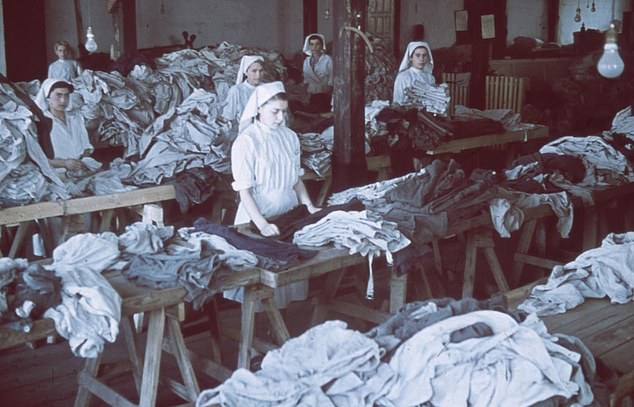
Amidst the death and disease of the Lodz Ghetto in occupied Poland that Jewish men, women and children were forced to make clothes for the Nazi regime and luxury goods for Third Reich civilians. Above: Jewish women sort through piles of garments
The images appear in new Lodz exhibition, ‘The Fashion System. Clothing in Violence Strategies and Survival Tactics in the Łódź Ghetto’.
Curator Karolina Sulaj said: ‘So-called departments were established in the ghetto, and most of them were involved in textile production.
‘Jewish men, women and children worked there because they wanted to live.
‘They worked for a bowl of soup and a chance to survive.
‘This ghetto was established as a production basin for the Reich’s economy, and in particular its clothing industry.
‘Fashion was created in departments, produced for the occupier in the hope that talented manufacturers and artists would buy themselves out of death in this way and the ghetto would survive.
‘Fashionable clothes, luxury accessories, footwear, conceptual exhibitions of things, artistic albums and fashion catalogues, which were produced and presented in the ghetto, hid the immensity of suffering of its inhabitants, their slave labour, exploitation and fear under the gilt of beauty.’
Art historian Anna Sańczuk added: ‘The Łódź ghetto was a large factory of luxury clothing and accessories.
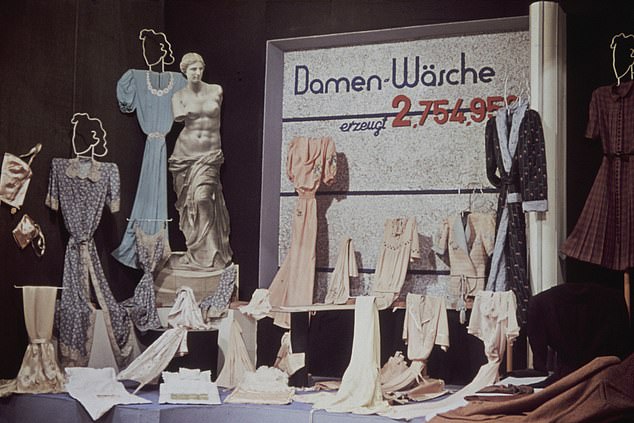
Displays of ladies’ dresses in a store. Jewish people were forced to make garments for the Nazi regime
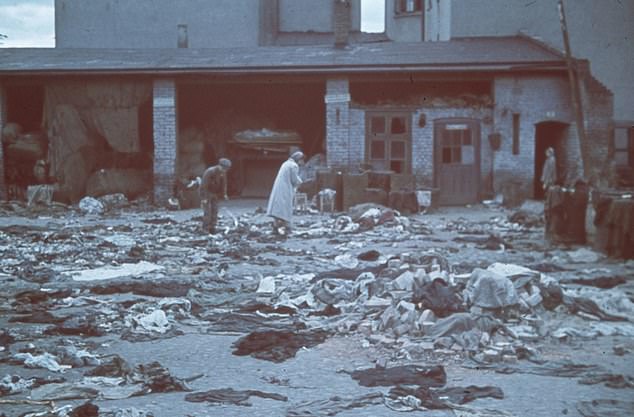
Piles of clothes from Kulmhof am Nehr extermination camp seen strewn across the streets in the Lodz Ghetto
‘Very little has been said about it. This is the first time the topic has been presented in the form of an exhibition.’
Established in October 1939 following Hitler’s invasion of Poland a month earlier, what was called the Litzmannstadt Ghetto by the Nazis grew to become the second largest in Nazi-occupied Europe.
By the time it was liquidated five years later, an estimated 45,000 Jews had died from famine and disease.
More than 140,000 others were murdered after being deported to Kulmhof am Nehr and its better-known counterpart, Auschwitz-Birkenau.
Of the 200,000 Jews incarcerated in the ghetto, by the end of the war less than 10,000 were left alive.
Lodz had for decades been home to highly skilled Jewish tailors, cobblers, textile workers and designers.
So once the Nazis took over, their talents were forcibly utilised.
The ghetto was overseen by Hans Biebow, a former coffee importer from Bremen.
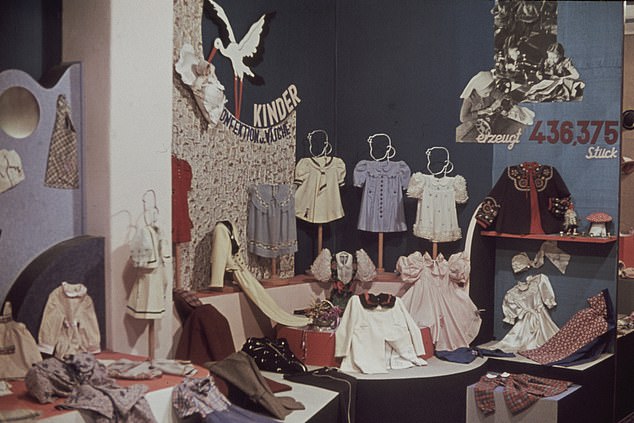
A display of children’s clothes made by Jewish people in the Lodz Ghetto
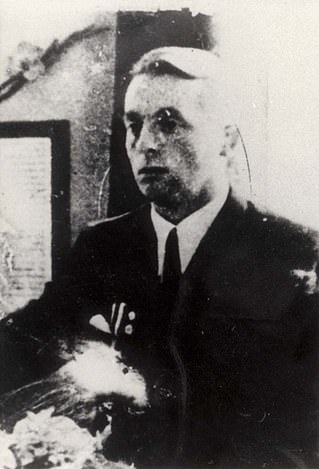
The ghetto was overseen by Hans Biebow, a former coffee importer from Bremen
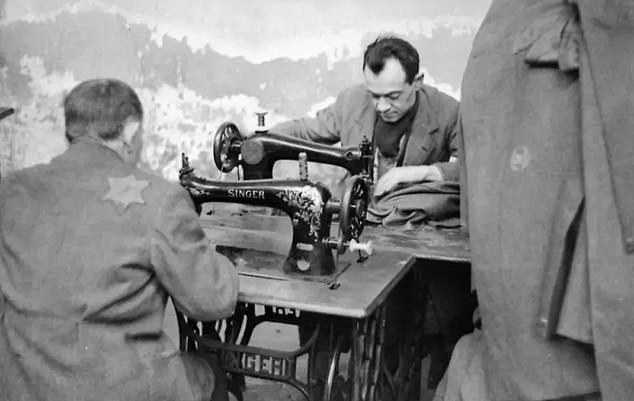
Jewish men seen using sewing machines to make clothes
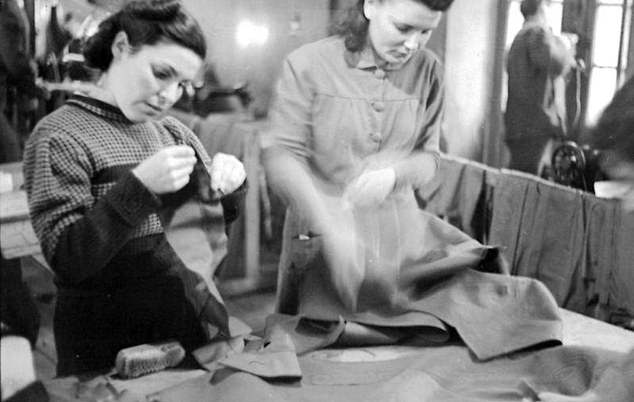
Women working with clothes from death camp victims
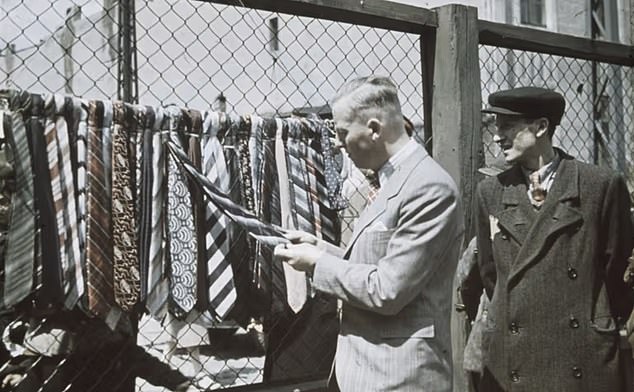
A well-dressed man inspects ties as he stands next to a Jewish local who is wearing the Star of David
The Nazi saw that the ghetto could make a profit for the Germans if it were converted into a slave labour complex.
The head of the city’s Jewish council of elders, insurance agent Chaim Mordechaj Rumkowski, dealt directly with the German authorities.
One of the first clothing factories to be set up produced luxury dresses, underwear and bed linen.
After starting production at the beginning of 1941 with 77 machines and 157 workers, by January 1942 there were 800 machines and more than 1,500 people working two shifts.
In addition to creating uniforms and insignia for the Wehrmacht, the ghetto’s textiles department found itself functioning like a legitimate fashion house, with its own look-books, fashion shows and photo shoots involving Jewish ‘models’ whose faces were later removed or silhouetted.
Co-curator of the exhibition, Pawel Michna, said: ‘According to Biebow, 90 percent of the ghetto’s production was intended for military purposes.
‘But the latest research shows that 50 percent of production went to the civilian market.
‘And this was the production of luxury items: hats, dresses, underwear – also for companies that still exist today and sell their underwear in Poland.’
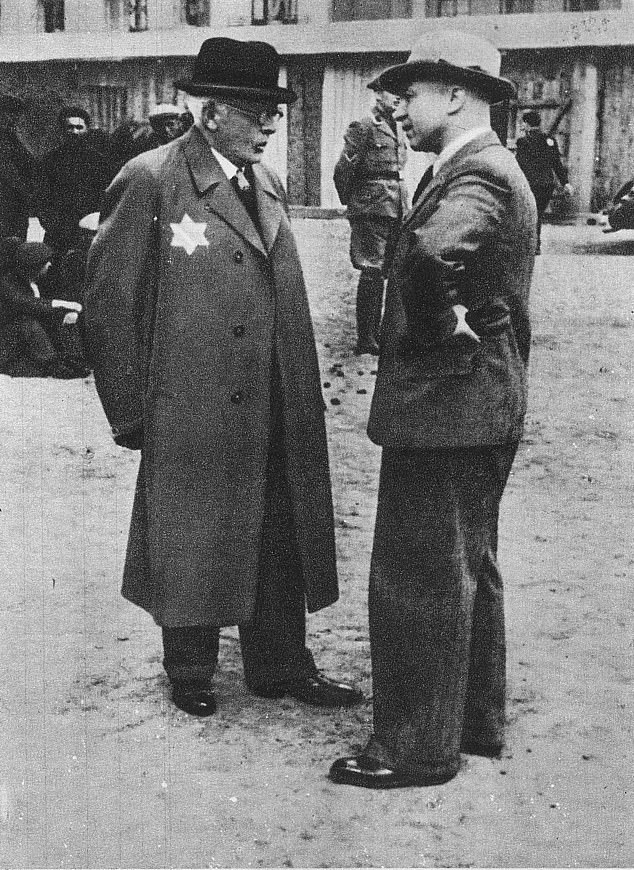
The head of the city’s Jewish council of elders, insurance agent Chaim Mordechaj Rumkowski (pictured above left with Biebow), dealt directly with the German authorities
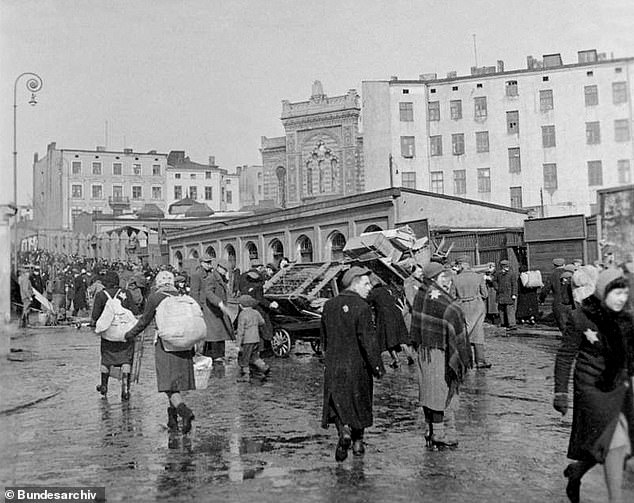
Jewish people seen wearing the Star of David in the Lodz Ghetto
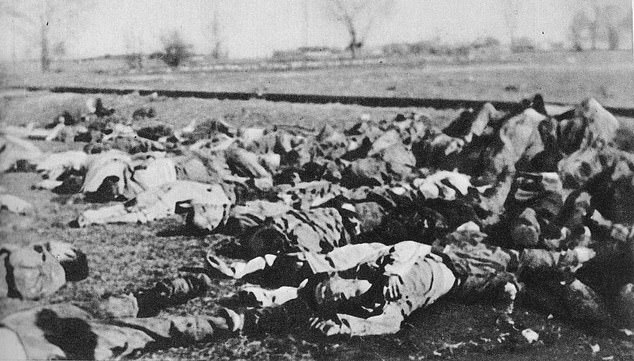
Bodies of Jews murdered at the Kulmhof am Nehr extermination camp
Karolina Sulaj said: ‘What happens to the goods when they leave production? They have to be sold and in order to sell, they have to be properly presented to customers.
‘In the Lodz ghetto, the role of catalogues was replaced by artistically made albums, but there were also fair stands, exhibitions, fancifully arranged to present products, to highlight their quality and beauty.
‘Like pages in albums or catalogues, the stands were carefully designed to make the greatest impression, draperies, signs, structures and scaffolding on which objects were mounted, mannequins made of artistically bent wire, as well as decorations that were to include the exhibition in the history of culture and civilisation, hence, for example, the plaster sculpture of the Venus de Milo.’
She added: ‘Such ghetto compositions were regularly visited by both the Jewish and German administration, as well as by officials and merchants from the Reich.
‘They tried to make these visual stories about products as sophisticated and spectacular as possible.
‘The lives of the ghetto inhabitants and their safety depended on sales successes and production orders, or at least that was what Rumkowski thought at the time.’
The meagre offer of an extra bowl of soup, however, didn’t stop the deaths and starvation.
With food rations often less than 600-800 calories a day, people were forced to eat anything they could find, including tree bark and potato skins.
Disease spread rapidly in the overcrowded and unsanitary conditions and a lack of proper medical care and medicines meant that simple ailments became deadly.
Working in the ‘high end’ fashion departments didn’t stop the slave workers from being deported to the death camps either.
Beginning in January 1942 and continuing non-stop until the ghetto’s liquidation in August 1944, the selection process was brutal and chaotic with roundups seeing victims chosen at random.
Survivor Eva Libitzky later recalled: ‘Rumkowski understood the difficult situation we were in.
‘So he concluded a unique agreement with the Germans, which was in force for the next four and a half years: he proposed that the ghetto, with its many factory buildings and skilled craftsmen, become a production centre for the needs of the Germans.
‘He believed that there was no other way for us to survive.
‘Faced with the threat of death, we became one of the largest industrial centres in the Reich.’
Ms Sulaj said: ‘Why has such a widely documented, important issue concerning the ghetto been hidden from mainstream knowledge about the Holocaust?
‘Unfortunately, because of our perception of how we define fashion today, as a trivial, commercial area.
‘The lens of fashion is a way to see the Lodz ghetto precisely and to see the essential dimension of its suffering and the previously unknown dimension of its resilience.’







